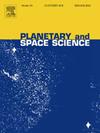On ore-bearing asteroid remnants in lunar craters
IF 1.7
4区 物理与天体物理
Q3 ASTRONOMY & ASTROPHYSICS
引用次数: 0
Abstract
We modify the probabilistic formalism developed by Elvis (2014) to estimate the number of lunar craters that contain ore-bearing asteroid remnants. When we consider craters at or above a threshold diameter of 1 km, we estimate an upper limit of craters with asteroid remnants containing significant amounts of platinum group metals and an upper limit of craters with asteroid remnants that contain significant amounts of water in the form of hydrated minerals. For a more conservative threshold of 5 km, we estimate craters with asteroid remnants that contain significant amounts of platinum group metals. These values are one to two orders of magnitude larger than the number of ore-bearing near-Earth asteroids estimated by Elvis (2014), implying that it may be more advantageous, and hence more profitable, to mine asteroids that have impacted the Moon rather than the ones that are in orbit.
月球环形山中的含矿小行星残骸
我们修改了Elvis(2014)开发的概率形式,以估计含有含矿小行星残骸的月球陨石坑的数量。当我们考虑阈值直径为1公里或以上的陨石坑时,我们估计含有大量铂族金属的小行星残留物的陨石坑的上限为~ 6500个,含有大量水合矿物形式的水的小行星残留物的陨石坑的上限为~ 3400个。对于更保守的5公里阈值,我们估计约400个陨石坑的小行星残骸含有大量的铂族金属。这些数值比Elvis(2014)估计的含矿近地小行星的数量大一到两个数量级,这意味着开采撞击月球的小行星比开采轨道上的小行星可能更有利,因此也更有利可图。
本文章由计算机程序翻译,如有差异,请以英文原文为准。
求助全文
约1分钟内获得全文
求助全文
来源期刊

Planetary and Space Science
地学天文-天文与天体物理
CiteScore
5.40
自引率
4.20%
发文量
126
审稿时长
15 weeks
期刊介绍:
Planetary and Space Science publishes original articles as well as short communications (letters). Ground-based and space-borne instrumentation and laboratory simulation of solar system processes are included. The following fields of planetary and solar system research are covered:
• Celestial mechanics, including dynamical evolution of the solar system, gravitational captures and resonances, relativistic effects, tracking and dynamics
• Cosmochemistry and origin, including all aspects of the formation and initial physical and chemical evolution of the solar system
• Terrestrial planets and satellites, including the physics of the interiors, geology and morphology of the surfaces, tectonics, mineralogy and dating
• Outer planets and satellites, including formation and evolution, remote sensing at all wavelengths and in situ measurements
• Planetary atmospheres, including formation and evolution, circulation and meteorology, boundary layers, remote sensing and laboratory simulation
• Planetary magnetospheres and ionospheres, including origin of magnetic fields, magnetospheric plasma and radiation belts, and their interaction with the sun, the solar wind and satellites
• Small bodies, dust and rings, including asteroids, comets and zodiacal light and their interaction with the solar radiation and the solar wind
• Exobiology, including origin of life, detection of planetary ecosystems and pre-biological phenomena in the solar system and laboratory simulations
• Extrasolar systems, including the detection and/or the detectability of exoplanets and planetary systems, their formation and evolution, the physical and chemical properties of the exoplanets
• History of planetary and space research
 求助内容:
求助内容: 应助结果提醒方式:
应助结果提醒方式:


